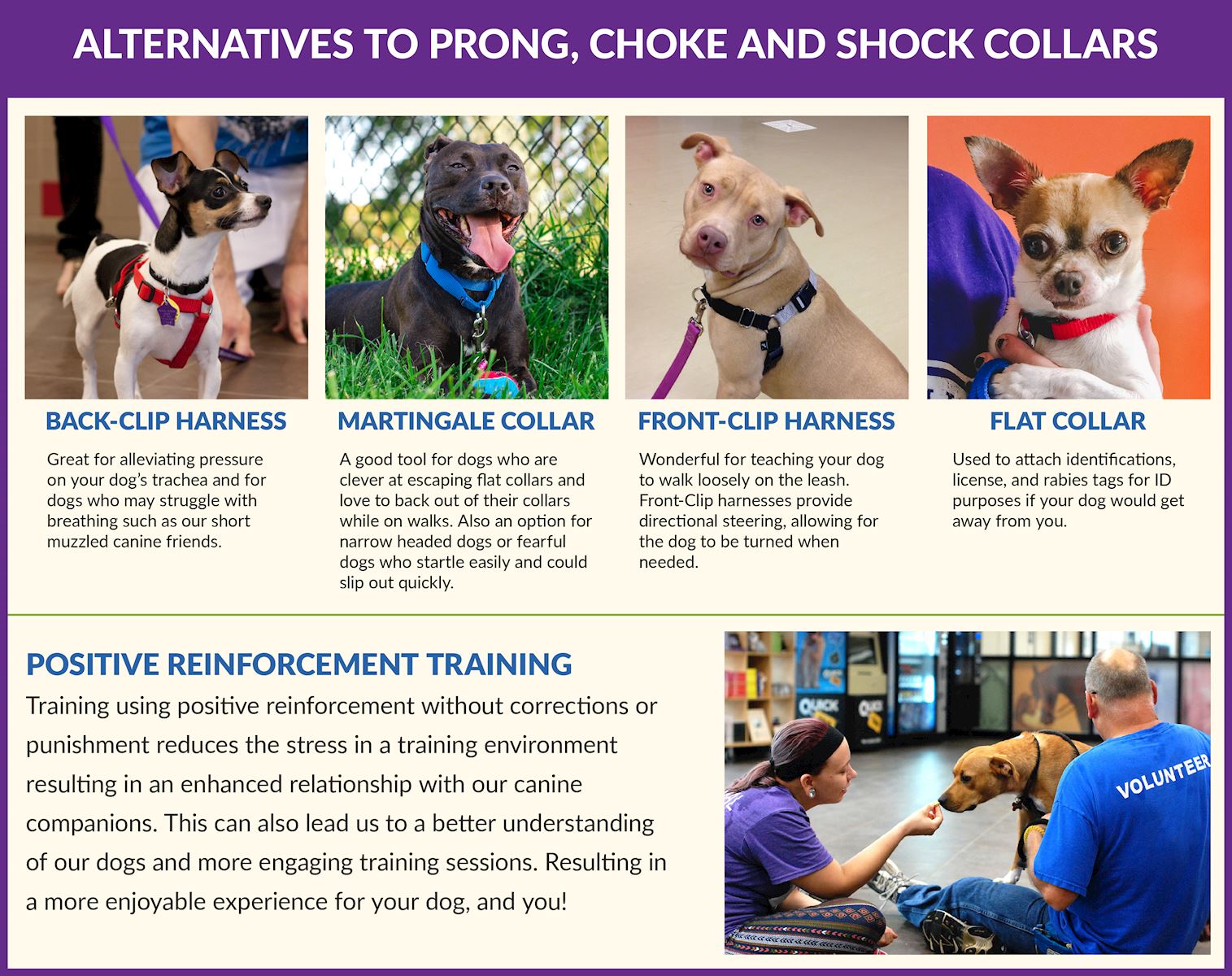posted
on Tuesday, August 10, 2021
in
Pet Help
Using the proper collar and leash is essential for creating an enjoyable experience for your dog, and you, whether attending events, going on their daily walk or exploring new territory! Prong collars, e-collars, and choke chains increase a dog’s discomfort level in their throat area when pressure or shock is applied, or emotionally since the dog may not understand why it’s happening.
Corrective tools like prong collars, e-collars, and choke chains do not provide long term solutions, they simply mask the behavior in that moment by causing discomfort. Just like humans, when a pet is in physical or emotional discomfort, their ability to focus decreases.
The Effects of Using of Prong/E-collars/Choke Chains
- Prolonged use can result in dogs becoming accustomed to the pain of the prong collar and eventually causing them to revert back to the behaviors that were initially deemed inappropriate.
- This will force the owners to apply more pressure or corrections to mask the behavior again. Masking the behavior does not provide long term solutions because the dog does not learn a desired response at the time of a correction.
- This can also increase the likelihood of potential trachea damage.
- When used on dog who has a history of reactive or aggressive displays (barking, growling, and lunging), we cannot control what the dog is associating the correction with.
- Frequently the association is not what we believe it to be. Due to this, sometimes the associations within the reactivity will worsen with the triggers causing them to be more reactive vs. helping them feel more comfortable.
- Reactive, aggressive or undesired behaviors displayed are a product of an emotion attached to a trigger.
- Attempting to eradicate this behavior by use of correction we are temporarily “fixing”, or masking, the behavior seen, but not focusing on WHY it’s happening. Identifying the “why” allows us to build positive associations to the triggers (other dogs, passing cars, loud noises, etc.) that currently make your dog feel uncomfortable and result in undesired behaviors.
- Masking a behavior can create a future escalation of the behavior and/or result in the dog not displaying warning signals leading to dogs “biting out of nowhere”.
Retractable Leashes
- Retractable leashes can be unsafe and unreliable. The longer the leash, the less control and the longer it takes to recall your dog if needed.
- Retractable leashes have been known to fail resulting in little-to-no control over the length of the lead and in potentially dangerous situations.
- It’s important to keep your dog close, under control and use an appropriate leash as a tool to move your dog to a safe space quickly.
Positive Alternatives
- Training using positive reinforcement without corrections or punishment reduces the stress in a training environment resulting in an enhanced relationship with our canine companions.
- This can also lead us to a better understanding of our dogs and more engaging training sessions. Resulting in a more enjoyable experience for your dog, and you!
- Standard six foot nylon leashes provide a safe distance and a safe amount of control if a dangerous situation arises.
- The following collars and harnesses provide a safe alternative: martingale collars, front clip harnesses, back clip harnesses, or flat collars.

Corrective Collar Myths
The Myth: “My dog can’t walk on a leash without a corrective collar because they pull too much.”
A dog can be taught to not pull on their leash. Corrective collars do not teach your dog to walk on a leash since the dog does not have direction on what they should be doing instead. The command of “stop pulling” does not provide specific direction on a task TO DO – instead it provides an unclear, overly broad suggestion of what they shouldn’t do from a human’s perspective that may result in a different undesired behavior.
The Myth: “I’ve tried training and it doesn’t work.”
Each dog learns differently and what works for one dog may not work for another. The ARL uses positive reinforcement training to create low stress and long term training solutions by associating desired behaviors with high value rewards. The rewards are also based on individual dogs since one high value reward (i.e. hot dogs) may not be high value to another dog who may prefer their favorite toy.
The ARL’s dedicated Behavior and Training team provides a variety of training classes including private classes which provide focused training strategies based on a dog’s learning style. Visit this link to learn more about classes or contact a member of our Behavior Team to identify what class works best for your dog.
Learn more about the ARL’s training philosophy here.